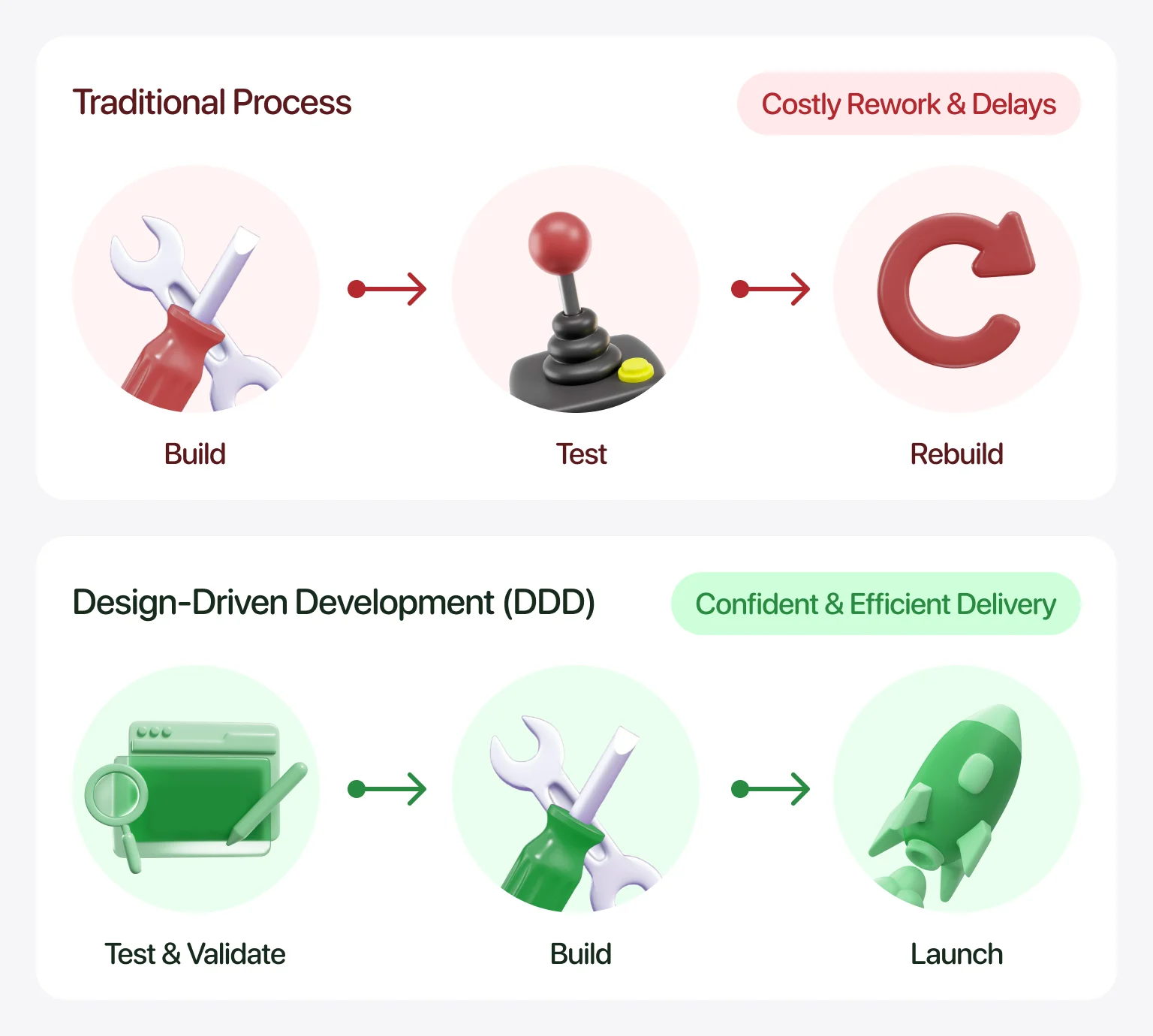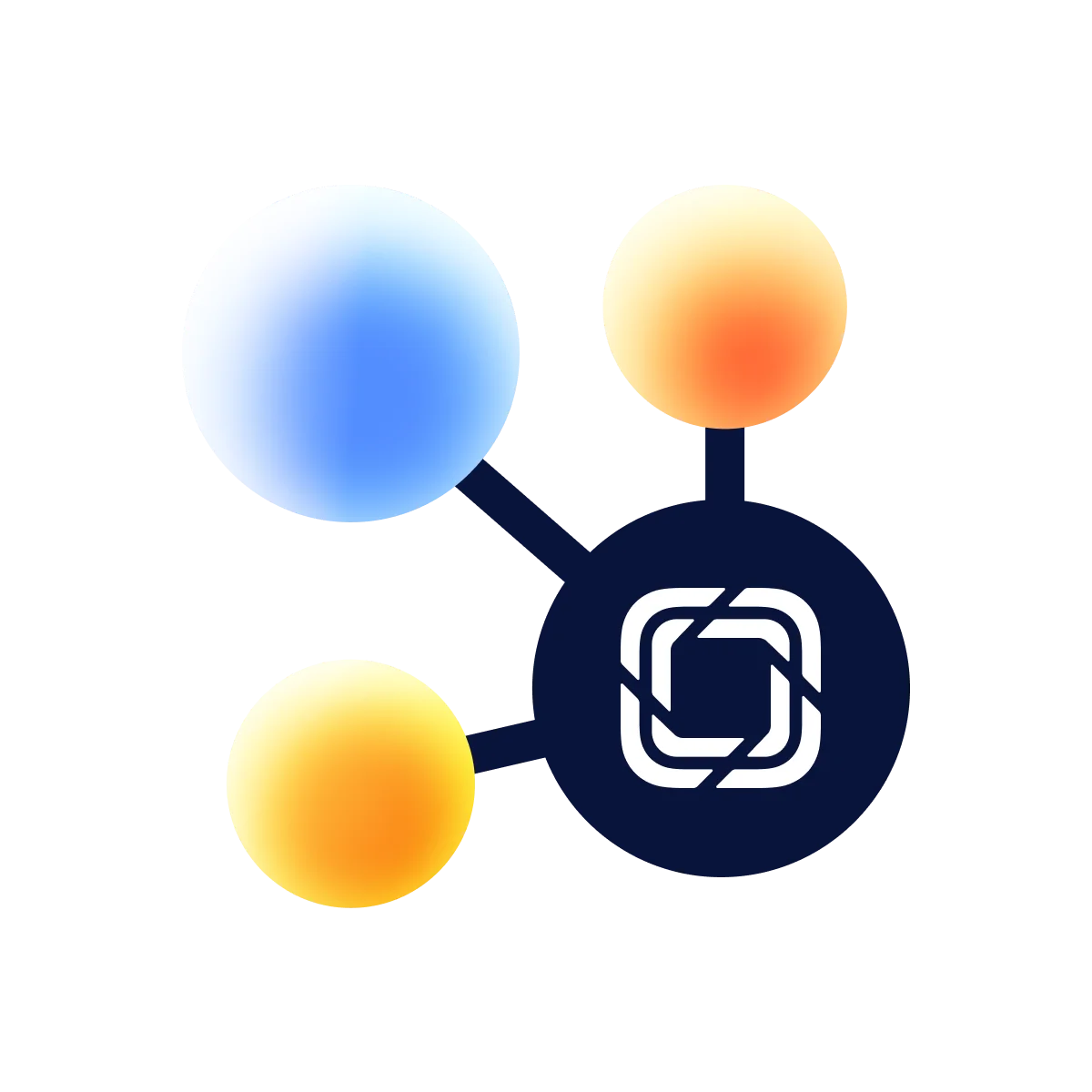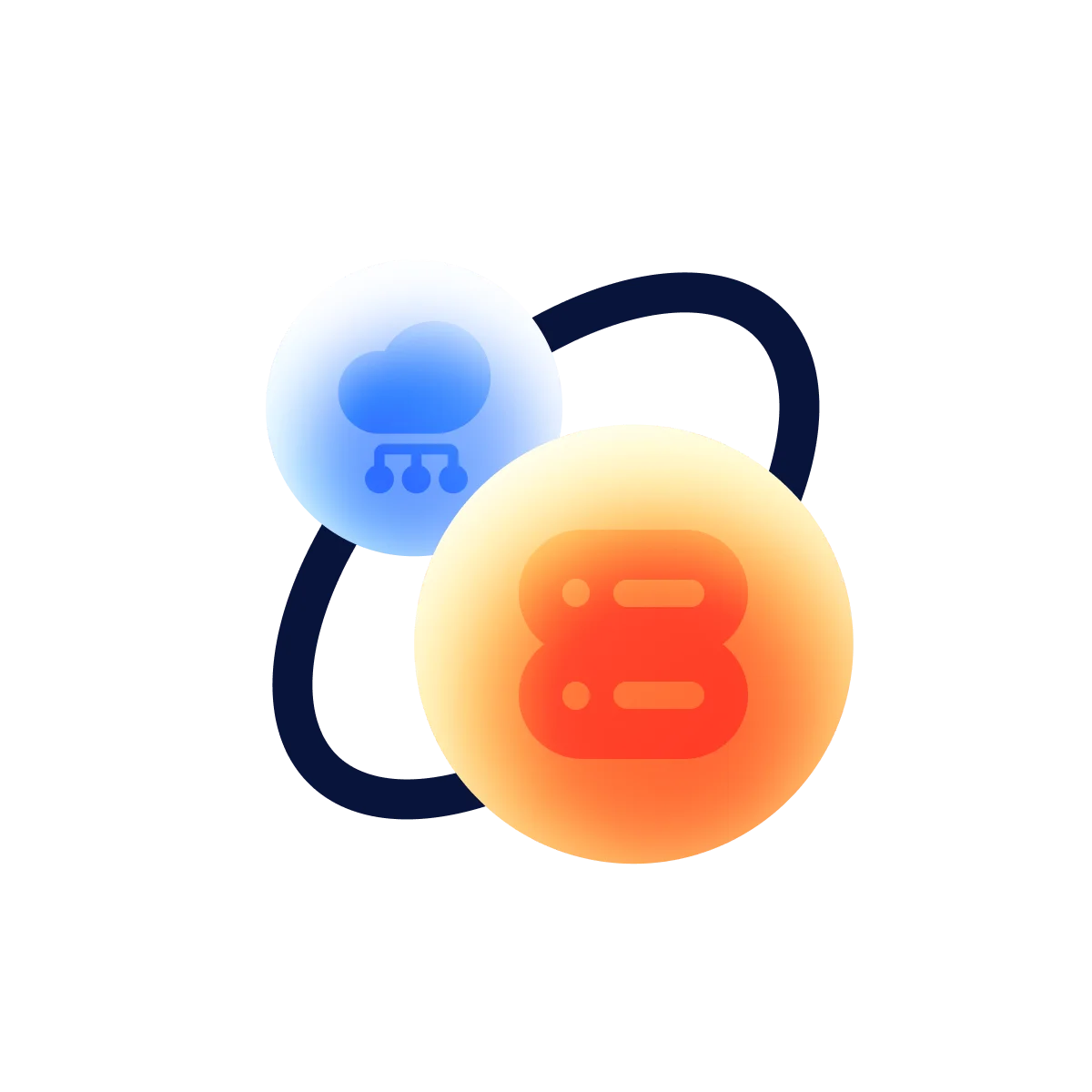In SaaS, pressure comes from both sides. Release cycles are getting shorter, yet expectations for polish keep climbing. Rushing features into production often leads to costly rework, while slow delivery leaves space for competitors to capture your audience. Design-driven development tackles both problems by uniting design and code from the outset, ensuring speed doesn’t come at the expense of building something people actually value.
A design-led approach flips the traditional building process on its head. Instead of starting with a feature list handed down from leadership, it begins with discovery. That means speaking directly with the people you aim to serve, watching how they currently solve the problem. The pain points you uncover become the foundation for early design concepts. When a prototype proves its value through repeated validation, development begins with confidence. In the article, we’ll break down how this approach works in practice and the challenges you need to plan for before adopting it.
Why design-driven development is a game changer for your SaaS product
The design-based method reshapes the development process by anchoring every decision in evidence, rather than assumption. Let’s examine how this methodology reduces wasted effort, accelerates delivery, enhances adoption, and maintains long-term system quality. Each point draws from practices that have proven their worth in real-world releases, where design drives development choices instead of reacting to them.
Faster time-to-market
A driven-by-design approach brings validation to the earliest stage of the product cycle. By testing ideas through prototyping before coding begins, you discover misalignments and usability issues while they are still inexpensive to address. This removes the need for late-stage overhauls and prevents bottlenecks caused by unplanned changes.
When the build starts with proven design decisions, development work proceeds with fewer interruptions. This predictability allows teams to seize market opportunities faster. More importantly, by launching a validated product from day one, companies avoid the all-too-common “launch-and-fix” cycle that cripples user activation rates and damages brand perception. A strong initial release is your best chance to maximize Day 1 retention and secure early adopters.
Focus on development and design prevents the chain reaction of redesigns, rewrites, and delayed releases that often occur when feedback only arrives after launch-ready code is in place.

Work smarter, make fewer mistakes
Clear collaboration between disciplines is one of the strongest defenses against wasted effort in software projects. In design-led development, shared design systems define how each component behaves in different contexts. These systems become a single source of truth, eliminating the risk of misinterpretation once work moves to engineering.
By aligning visual design, interaction patterns, and functional logic upfront, there is less room for surprises during development or quality assurance. The result is a more consistent product experience and fewer rounds of back-and-forth fixes.
Save money by fixing problems early
Design decisions validated early in the process save significant time and money. Industry data shows the cost of fixing a problem balloons dramatically the later it’s detected. Research notes that addressing an error after development can cost up to 100 times more than fixing it during the design phase.
One way to comprehend that scale: if a design-level issue takes an hour to correct, discovering it during development might require a full day — or even more cost if found after launch, when bug fixes can spiral into weeks of work. Design investments aren’t mere niceties — they’re powerful cost-avoidance tools.
.webp)
Create a smooth experience for SaaS business growth
As products scale, additional features and market-specific adaptations can easily erode the original user experience. Without a guiding usability strategy, the interface becomes inconsistent and harder to navigate. Design-driven development counteracts this by mapping every new element against the existing journey before a single line of code is written.
This approach ensures that growth directly translates into revenue. A cohesive user journey directly improves conversion rates at key funnel stages, whether it’s upgrading a plan or activating a new feature. Furthermore, an intuitive and consistent interface slashes the first-time user bounce rate and shortens the time-to-value, turning new sign-ups into engaged, paying customers faster. Each release strengthens the overall narrative, rather than fragmenting it, which keeps long-term users engaged and makes onboarding for new customers more intuitive. Learn more in our guide on how to design a SaaS product.
.webp)
Make your users love your software
While features may attract initial attention, the lasting perception of an application is shaped by how it feels to use. In design-driven development, emotional resonance is treated as a goal from the start. Decisions about flow, micro-interactions, and visual hierarchy are validated with real people to ensure they deliver not utility alone but a sense of satisfaction.
When functionality and experience reinforce each other, adoption rates improve and churn decreases. Over time, this builds a loyal customer base that values the product for more than its technical capabilities, making it harder for competitors to replace. If you want your software to create that kind of connection, our SaaS design experts can help you shape experiences that keep customers engaged and loyal.
Challenges of design-led development in SaaS and how to overcome them
Such a strategy can create products that feel sharp and relevant, but the process has its pressure points. Once the first release is out, new problems emerge — growth strains consistency, budgets get stretched, and design priorities can slip. Addressing these issues early protects the service’s long-term value.
Keeping users hooked
When teams treat every feature release as an opportunity to understand shifts in behavior — like which screens clients linger on or which workflows they abandon — they spot friction early. A study of nearly 40 organizations reveals that active feedback loops, ranging from in-app tools to social listening, facilitate continuous user feedback for refining the experience over time.
Building on that insight means targeting specific behaviors that signal a need for adjustment. If analytics indicate that customers bypass a function after their first attempt, you can introduce a single, well-timed interaction to guide them back. Iterating on these micro-moments ensures that improvements are tested in real-world usage, avoiding the disruption of large-scale redesigns while steadily increasing engagement.
.webp)
Growing without issues
As a SaaS system expands, inconsistencies surface when design decisions are left implicit. A design system, complete with documented components and behavior rules, acts as a reference that ensures each new feature aligns with the existing experience. For example, Wikipedia defines design systems as a framework that unifies styling, layout, and logic across teams and releases.
This clarity prevents fragmentation when multiple contributors are involved. Companies that commit to a design system report faster handoffs and fewer “why doesn’t that match?” questions. The result is growth that retains coherence — and protects trust earned through consistency.
Staying profitable
Scope creep can derail budgets without dramatic signs: 85% of affected projects exceed their budgets by an average of 27%. These small but persistent overruns undermine timelines and drain capital. Design-driven development replaces guesswork with validation. Only features proven to deliver value in testing are included in the build roadmap.
This discipline matters. When every proposed addition must first prove its value, companies avoid diverting resources to changes that may not yield a return. The result: profitability is maintained, timelines remain realistic, and product evolution remains intentional, not reactionary.
“Profit stays intact when every feature earns its place — validation over assumptions drives disciplined growth and timely delivery.” {{valentine-boyev}}
How to measure the impact of design-driven development initiatives
A driven-by-design approach gains credibility when its results are measurable. Without evidence, it risks being dismissed as a creative exercise rather than a growth driver. Tracking key indicators enables design decisions to become business outcomes, revealing which efforts deliver real value. If you want to incorporate these principles into your process and achieve measurable improvements, consider our design services to transform early insights into lasting product performance. Now, let’s go into more detail on how to accurately measure results:
- Bug counts as proof of early validation.
A steady decline in post-launch bug reports signals that potential issues are being resolved before code is written. Early prototype testing acts as a filter, preventing flawed logic or incomplete flows from reaching production. Reviewing these figures across multiple releases reveals the effectiveness of the validation stage. - Development velocity and delivery confidence.
Comparing sprint completion rates before and after adopting design-driven development exposes the influence of clear specifications. When teams work from tested prototypes, they spend less time clarifying requirements and more time building. The result is a steadier pace without a drop in quality. - User satisfaction beyond surface opinions
Net Promoter Score (NPS) and Customer Satisfaction Score (CSAT) offer a blend of emotional and practical feedback. Strong results after a release suggest that the experience aligns with what was promised in design. When paired with qualitative insights, these scores pinpoint areas for refinement or expansion. - Churn rate as a retention signal
A falling churn rate reflects stronger alignment. By basing feature building on verified needs, design-led development makes the product harder to replace. Tracking this metric over time highlights the lasting influence of early design decisions. - Budget adherence as a discipline check
The smaller the gap between estimated and actual costs, the more controlled the workflow will be. Validating ideas before committing resources reduces waste and keeps budgets predictable. Over several release cycles, this discipline compounds into significant savings.
“Design’s true credibility is earned not through aesthetics, but through the hard evidence of business outcomes.” {{valentine-boyev}}
Examples of successful SaaS companies using design-driven development
Many high-performing SaaS companies integrate design-oriented building principles into their process without advertising it as a formal method. They iterate relentlessly, refine based on observation, and make verified design outcomes that shape development rather than decorate it. Below are examples that show the variety of ways design-led development can influence outcomes:
- Slack created the Slack Kit, a unified design system that enabled teams across disciplines to work from shared components and style rules. This system drastically reduced design-to-development handoff overhead, allowing new features to be built in hours instead of weeks.
.webp)
- Spotify’s “Discover Weekly” playlist uses machine learning to personalize recommendations based on individual listening habits. This personalization enhances engagement and retention.
- Dropbox’s redesign of its Android app exemplifies “invisible design,” simplifying the interface to just four essential buttons for core functionality. This streamlined approach reduced clutter while preserving brand personality through playful animations.
- Airbnb used a consistent cross-platform visual language — shared navigation, typography, motion, and iconography — to boost clarity across diverse global audiences. This design coherence helped earn them a Material Design Award, supported by thousands of five-star reviews.
While the mentioned examples from product giants are compelling, the true power of design-driven development shines in its ability to bring the same clarity to complex, specialized domains. It’s here, away from the spotlight, that the method proves to be an indispensable strategic tool.
The same principles are equally transformative for B2B and deep-tech products operating in complex domains. Whether it’s Linkbycar modeling intricate relationships between vehicles and maintenance, FlowApps ensuring the integrity of business workflow rules, Praiseworthy cleanly separating data collection from presentation logic, or Catalyze managing the rigorous demands of life sciences compliance — a design-driven approach provides the clarity and structure to tame complexity. In each case, building the model first creates a precise “ubiquitous language” that aligns the entire team, ensuring the final system is not only robust and adaptable but also faithfully reflects the intricate realities of the business it serves.
How to start with design-driven development
Introducing a design-led approach into a SaaS workflow doesn’t require dismantling everything you already have. The most effective transitions begin with targeted actions that quickly prove value. Start by speaking directly with a small group of customers before any MVP specifications are written.
This approach builds a cycle of iterations that avoids costly rework, delivers tools that resonate, and evolves in step with the market. Regular usability testing before each release keeps the product aligned with real-world expectations. Embrace these principles to not only adapt to the future, but to define it. With our UI/UX design services, turn your early insights into a product vision that captivates, leads, and inspires.
in your mind?
Let’s communicate.

Frequently Asked Questions
What’s the difference between design-driven development and user-centered design?
User-centered design focuses on meeting end-customer needs during the design phase, whereas design-driven development integrates that focus throughout the entire development process. This ensures client insights shape both the look and the technical build from the start.
Can design-driven development work for small SaaS teams?
Yes — even two-person teams benefit from early prototypes and shared vision. Smaller teams often move faster because there are fewer communication layers.
Do we need a full-time designer to adopt design-driven development?
No. Freelancers or agencies can lead design decisions as long as design is central to the process from day one.
Is design-driven development only for customer-facing SaaS?
Not at all — internal tools and B2B platforms gain the same usability benefits. The principles apply wherever user experience matters.
How soon can we expect ROI?
Many see results, such as fewer bugs and faster releases, within a couple of product cycles. The full payoff grows as your team becomes fluent in design-driven development.
Create a smooth experience for SaaS business growth
As products scale, additional features and market-specific adaptations can easily erode the original user experience. Without a guiding usability strategy, the interface becomes inconsistent and harder to navigate. Design-driven development counteracts this by mapping every new element against the existing journey before a single line of code is written.
This approach ensures that growth directly translates into revenue. A cohesive user journey directly improves conversion rates at key funnel stages, whether it’s upgrading a plan or activating a new feature. Furthermore, an intuitive and consistent interface slashes the first-time user bounce rate and shortens the time-to-value, turning new sign-ups into engaged, paying customers faster. Each release strengthens the overall narrative, rather than fragmenting it, which keeps long-term users engaged and makes onboarding for new customers more intuitive. Learn more in our guide on how to design a SaaS product.
Make your users love your software
While features may attract initial attention, the lasting perception of an application is shaped by how it feels to use. In design-driven development, emotional resonance is treated as a goal from the start. Decisions about flow, micro-interactions, and visual hierarchy are validated with real people to ensure they deliver not utility alone but a sense of satisfaction.
When functionality and experience reinforce each other, adoption rates improve and churn decreases. Over time, this builds a loyal customer base that values the product for more than its technical capabilities, making it harder for competitors to replace. If you want your software to create that kind of connection, our SaaS design experts can help you shape experiences that keep customers engaged and loyal.
Challenges of design-led development in SaaS and how to overcome them
Such a strategy can create products that feel sharp and relevant, but the process has its pressure points. Once the first release is out, new problems emerge — growth strains consistency, budgets get stretched, and design priorities can slip. Addressing these issues early protects the service’s long-term value.
Keeping users hooked
When teams treat every feature release as an opportunity to understand shifts in behavior — like which screens clients linger on or which workflows they abandon — they spot friction early. A study of nearly 40 organizations reveals that active feedback loops, ranging from in-app tools to social listening, facilitate continuous user feedback for refining the experience over time.
Building on that insight means targeting specific behaviors that signal a need for adjustment. If analytics indicate that customers bypass a function after their first attempt, you can introduce a single, well-timed interaction to guide them back. Iterating on these micro-moments ensures that improvements are tested in real-world usage, avoiding the disruption of large-scale redesigns while steadily increasing engagement.
Growing without issues
As a SaaS system expands, inconsistencies surface when design decisions are left implicit. A design system, complete with documented components and behavior rules, acts as a reference that ensures each new feature aligns with the existing experience. For example, Wikipedia defines design systems as a framework that unifies styling, layout, and logic across teams and releases.
This clarity prevents fragmentation when multiple contributors are involved. Companies that commit to a design system report faster handoffs and fewer “why doesn’t that match?” questions. The result is growth that retains coherence — and protects trust earned through consistency.
Staying profitable
Scope creep can derail budgets without dramatic signs: 85% of affected projects exceed their budgets by an average of 27%. These small but persistent overruns undermine timelines and drain capital. Design-driven development replaces guesswork with validation. Only features proven to deliver value in testing are included in the build roadmap.
This discipline matters. When every proposed addition must first prove its value, companies avoid diverting resources to changes that may not yield a return. The result: profitability is maintained, timelines remain realistic, and product evolution remains intentional, not reactionary.
“Profit stays intact when every feature earns its place — validation over assumptions drives disciplined growth and timely delivery.”
How to measure the impact of design-driven development initiatives
A driven-by-design approach gains credibility when its results are measurable. Without evidence, it risks being dismissed as a creative exercise rather than a growth driver. Tracking key indicators enables design decisions to become business outcomes, revealing which efforts deliver real value. If you want to incorporate these principles into your process and achieve measurable improvements, consider our design services to transform early insights into lasting product performance. Now, let’s go into more detail on how to accurately measure results:
- Bug counts as proof of early validation.
A steady decline in post-launch bug reports signals that potential issues are being resolved before code is written. Early prototype testing acts as a filter, preventing flawed logic or incomplete flows from reaching production. Reviewing these figures across multiple releases reveals the effectiveness of the validation stage. - Development velocity and delivery confidence.
Comparing sprint completion rates before and after adopting design-driven development exposes the influence of clear specifications. When teams work from tested prototypes, they spend less time clarifying requirements and more time building. The result is a steadier pace without a drop in quality. - User satisfaction beyond surface opinions
Net Promoter Score (NPS) and Customer Satisfaction Score (CSAT) offer a blend of emotional and practical feedback. Strong results after a release suggest that the experience aligns with what was promised in design. When paired with qualitative insights, these scores pinpoint areas for refinement or expansion. - Churn rate as a retention signal
A falling churn rate reflects stronger alignment. By basing feature building on verified needs, design-led development makes the product harder to replace. Tracking this metric over time highlights the lasting influence of early design decisions. - Budget adherence as a discipline check
The smaller the gap between estimated and actual costs, the more controlled the workflow will be. Validating ideas before committing resources reduces waste and keeps budgets predictable. Over several release cycles, this discipline compounds into significant savings.
“Design’s true credibility is earned not through aesthetics, but through the hard evidence of business outcomes.”
Examples of successful SaaS companies using design-driven development
Many high-performing SaaS companies integrate design-oriented building principles into their process without advertising it as a formal method. They iterate relentlessly, refine based on observation, and make verified design outcomes that shape development rather than decorate it. Below are examples that show the variety of ways design-led development can influence outcomes:
- Slack created the Slack Kit, a unified design system that enabled teams across disciplines to work from shared components and style rules. This system drastically reduced design-to-development handoff overhead, allowing new features to be built in hours instead of weeks.
- Spotify’s “Discover Weekly” playlist uses machine learning to personalize recommendations based on individual listening habits. This personalization enhances engagement and retention — paid subscribers stay with the service at rates over 60%, in part due to tools like these.
- Dropbox’s redesign of its Android app exemplifies “invisible design,” simplifying the interface to just four essential buttons for core functionality. This streamlined approach reduced clutter while preserving brand personality through playful animations.
- Airbnb used a consistent cross-platform visual language — shared navigation, typography, motion, and iconography — to boost clarity across diverse global audiences. This design coherence helped earn them a Material Design Award, supported by thousands of five-star reviews.
While the mentioned examples from product giants are compelling, the true power of design-driven development shines in its ability to bring the same clarity to complex, specialized domains. It’s here, away from the spotlight, that the method proves to be an indispensable strategic tool.
The same principles are equally transformative for B2B and deep-tech products operating in complex domains. Whether it’s Linkbycar modeling intricate relationships between vehicles and maintenance, FlowApps ensuring the integrity of business workflow rules, Praiseworthy cleanly separating data collection from presentation logic, or Catalyze managing the rigorous demands of life sciences compliance — a design-driven approach provides the clarity and structure to tame complexity. In each case, building the model first creates a precise “ubiquitous language” that aligns the entire team, ensuring the final system is not only robust and adaptable but also faithfully reflects the intricate realities of the business it serves.
How to start with design-driven development
Introducing a design-led approach into a SaaS workflow doesn’t require dismantling everything you already have. The most effective transitions begin with targeted actions that quickly prove value. Start by speaking directly with a small group of customers before any MVP specifications are written.
This approach builds a cycle of iterations that avoids costly rework, delivers tools that resonate, and evolves in step with the market. Regular usability testing before each release keeps the product aligned with real-world expectations. Embrace these principles to not only adapt to the future, but to define it. With our UI/UX design services, turn your early insights into a product vision that captivates, leads, and inspires.




























